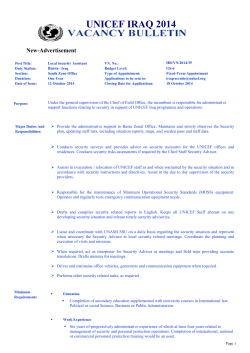
Read Campaign Q&A
May 18th, 2015 Q+A FOR UNICEF GLOBAL INNOVATION CENTER + CAUSETECH.NET What is the significance of Innovation to UNICEF? UNICEF is committed to ensuring innovative solutions be scaled to address solutions for all. Despite incredible developments and technological advances across the globe, there are still many populations that are remote and deprived. Our development strategy is to be the connector between all the relevant actors in the value chain, to ensure innovative solutions be successfully implemented and scaled across regions and contexts. Achieving our goal of reaching every child requires disrupting 'business as usual.' New ways of thinking have to be developed. Assumptions and strategies must change. That's why innovation is so important. Where do you see the biggest need for UNICEF around the world today? At the top of our hierarchy of need is access to information. An informed society makes for strong citizens, which in turn makes for a strong nation. Our focus is areas are those of inequity and disparity. So we look to address those population groups living in remote, inaccessible areas, with lack of infrastructure, as well as children with disabilities and special needs. We need to develop solutions as scale to address these inequities. How do you quantify your mission and mandate? We are working in 190 countries and addressing all children. When we look at solutions we take a nation-‐level approach and then multiply those solutions across countries and across regions. To do this, we have 10 active innovation labs and work with many partners in both the academic and private sector. Our approach to innovation is based on our innovation principles, which highlight human-‐centered design, designing for scale, utilizing open source data, and working in collaboration with relevant partners. So in essence we ask, we make, and we scale. And we measure innovation in various ways. Measurement stems from how we define success to begin with. Depending on the context, we might measure success by behavioral changes, number of people using the tool, etc. So first we decide what success means and then we have a context for determining how we can measure innovation performance. What is your advocacy position? The market has tools and capacity to make a difference in the lives of billions of people. But to really achieve this change, we need to work together. What is precipitating the launch of CauseTech? We are seeing a shift in private sector companies away from competition and towards collaboration. Companies see that by pulling in the resources and strengths of different groups, they can really extend their value proposition. This is the same in the social sector. We realize that we cannot achieve everything on our own, and while we are experts in development we don't necessarily have the technological background to ensure the best solutions can be found and scaled. The goal of CauseTech is to expand the sphere of how we look at private public partnerships so that we can really go beyond philanthropy and move towards engagement. Through CauseTech, we can pull in all the different actors in the value chain, including VCs, entrepreneurs themselves, incubators, R&D centers, and technology hubs. What's the benefit of CauseTech and the crowdsourcing of ideas? We believe that for the global challenges we are addressing, the solutions are out there. We just need to find them, and convert them into scalable technologies that can achieve real social impact. We need to tap into both sides. We need the innovators to create solutions. And at the same time we need to tap into the ideas from the people that are facing these challenges every day. CauseTech allows all actors in the value chain to come together, so that the people on the ground can connect with those creating these innovative technologies and vice versa, and we can ensure that the right innovations are chosen and scaled. How does UNICEF see its role in the private/public sphere? We see our role as stimulating funds that have high value. We are a connector. As an organization with over 60 years of presence in the field, we have the right networks and the credibility to make a real impact. We want to facilitate the process so that all these different groups can work together. We want people to innovate on their business model. The continuum needs to be completed. Otherwise the value chain breaks down. Have you seen an increase in millennial interest in the area of social impact? Absolutely. In many ways the shift in the private sector has been achieved because of the strong millennial mindset and drive towards social impact. The community is becoming stronger, more informed, and is giving voice to the work we are doing. We need millennial across the globe to become a part of the solution. We think about development as 'of the people, by the people, for the people,' but to do these we need to engage and empower these youths. What are some of the most exciting technologies that can help advance the work UNICEF is doing? The largest impediment to successful development is the delay of movement of information and the lack of access to information overall. There are large populations of youth that want to be a part of society and development but who are disconnected from the information that could empower them. So with this, we are looking for technologies that cut down the delay in information distribution and access. We need tools that can provide access to quality learning and information. Economic status and location cannot be indicative of future possibilities. We see mobile phones as a great tool for these solutions. Phones allow for quick dissemination of information, which allows people to move from being simply recipients of development to becoming actively involved throughout the development process. We need community members to become part of the solutions. This is the only way to ensure sustainability in the long run. Some of the technologies we are currently using include: • U-‐Report: a tool for creating communities and conversations around realtime information loops through basic mobile phones • mTrac & EduTrac: Tools to support health workers and teachers • RapidPro: a platform for developing apps like U-‐Report, mTrac, and EduTrac What are some of the complexities of deploying technologies in remote parts of the world? We find that hardware and energy access are the biggest impediments to technology deployment. So we're really looking for technologies that can help us surpass those hurdles. Even those people without and education can gain access to information through technology. Through that information they can quickly become more intelligent about the world around them. Once people see the ROI of that technology they are quick to adopt it. So we need to get these technologies in the hands of the people so they can really become a part of the development process and create these changes for themselves. How do you get past some of the complexities to scale technologies, including the need to change the interface, ruggedize the technology, and scale them? Our methodology is to look at what people already have and build on that. If we take Africa as an example, we ask, how are people using their mobile phones? And we see that 85% are using them for talking and texting. So we build the solution around that and look at how we can provide solutions around simple text messaging for a basic mobile phone. So, we design and develop solutions with and for the people who will actually use it. That way, we know the solutions will actually work. What is your message to Silicon Valley? Silicon Valley has both the technology and the capacity to actually change the world. The people here have the skills to bring about unimaginable changes in the very short term. We see the potential here where that people will not have to wait for solutions. Silicon Valley can revolutionize development. With the skill set here, coupled with the human capacity and ideas we see in people around the world and together with our experience, we can achieve change that improves the lives of billions. ###
© Copyright 2025


















